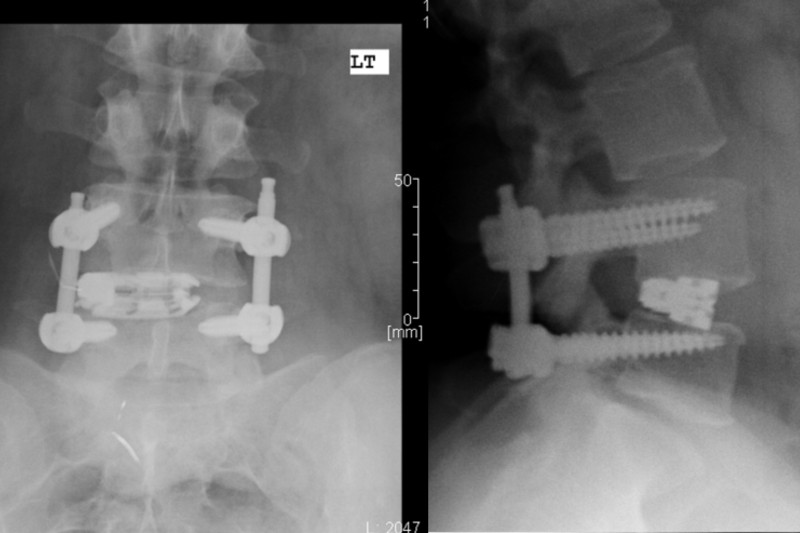There are a number of spine conditions for which the loss of stability within the spine results in back pain and nerve compression. In these situations, a fusion is necessary to both re-establish the stability and restore the natural alignment of the spine.
Posterior Lumbar Interbody Fusion (PLIF)
An “interbody fusion” involves removing the diseased and dysfunctional disc and replacing it with a spacer in order to restore normal anatomy.
Posterior Lumbar Interbody Fusion (PLIF) is a type of spinal fusion performed by placing a spacer between the vertebrae. Conditions such as lumbar spondylolisthesis, lumbar disc degeneration and scoliosis can be treated with a PLIF. There are some technical differences between the PLIF and TLIF in terms of how the disc is accessed during surgery but the final radiographic appearance is essentially the same and the results are comparable.
Implants inserted in a PLIF, in addition to the spacer, include specially-designed titanium screws and rods, which provide additional support to the spine during the healing process.
Bone graft is also utilized during all fusion procedures. It is typically a combination of autograft (patient’s own bone) and allograft (sterilized donated bone). These bone grafts are then inserted into the cage/spacer and around the spine and serve as the scaffolding upon which the patient will lay down their own bone (fusion bone).
After surgery:
Once surgery is complete the patients will spend a few hours in the surgical recovery area for monitoring.
- Patients typically will spend one to two nights in the hospital and are able to walk immediately as they work with a physical therapist.
- A lower back brace may be provided to support the lumbar spine.
All surgical patients at Comprehensive Spine Care are provided with medications prior to the date of surgery with instructions on their post-operative usage. Wound care, medication and diet instructions for after surgery are also provided upon discharge from the hospital and are also available here.
Transforaminal Lumbar Interbody Fusion (TLIF)
There are a number of spine conditions for which the loss of stability within the spine results in back pain and nerve compression. In these situations, a fusion is necessary to both re-establish the stability and restore the natural alignment of the spine.
Minimally-Invasive TLIF
An “interbody fusion” involves removing the diseased and dysfunctional disc and replacing it with a spacer in order to restore normal anatomy.
Transforaminal Lumbar Interbody Fusion (TLIF) is a type of spinal fusion that, where appropriate, is often performed in a minimally-invasive fashion. Performing this operation via a minimally-invasive approach has the potential to cause less postoperative pain, and often less time spent in the hospital. Conditions such as lumbar spondylolisthesis, lumbar disc degeneration and scoliosis can be treated with a TLIF. There are some technical differences between the TLIF and PLIF in terms of how the disc is accessed during surgery but the final radiographic appearance is essentially the same and the results are comparable.
Implants inserted in a TLIF, in addition to the spacer, include specially designed titanium screws and rods, which provide additional support to the spine during the healing process.
Bone graft is also utilized during all fusion procedures. It is typically a combination of autograft (patient’s own bone) and allograft (sterilized donated bone). These bone grafts are then inserted into the cage and around the spine and serve as the scaffolding upon which the patient will lay down their own bone (fusion bone).
After surgery:
Once the surgery is complete the patients will spend a few hours in the surgical recovery area for monitoring.
- Patients typically will spend one to two nights in the hospital and are able to walk immediately as they work with a physical therapist.
- A lower back brace may be provided to support the lumbar spine.
All surgical patients at Comprehensive Spine Care are provided with medications prior to the date of surgery with instructions on their post-operative usage. Wound care, medication, and diet instructions for after surgery are also provided upon discharge from the hospital and are also available here.











 in CA by O360®
in CA by O360®